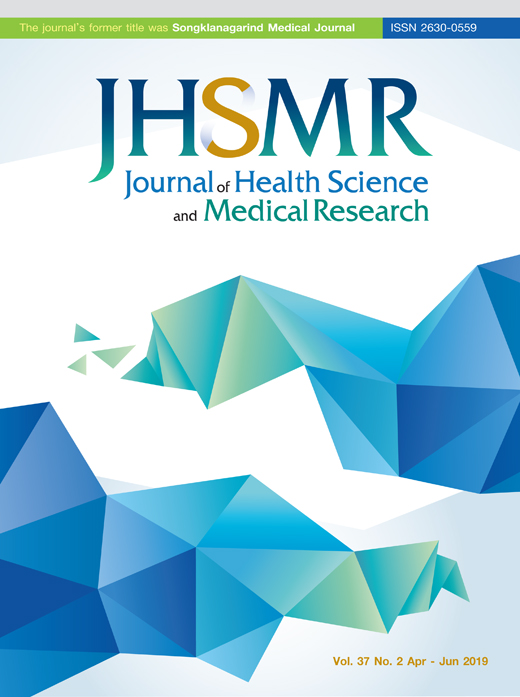Prevalence of Noise-Induced Hearing Loss in Workers with Noise Exposure in Panyananthaphikkhu Chonprathan Medical Center, Srinakharinwirot University
DOI:
https://doi.org/10.31584/jhsmr.201941Keywords:
extended high frequency audiometry, high frequency audiometry, noise-induced hearing loss, ThailandAbstract
Objective: To determine the prevalence of noise-induced hearing loss (NIHL) in workers in Panyananthaphikkhu Chonprathan Medical Center, Srinakharinwirot University (PCMC). The risk factors associated with noise-induced hearing loss were evaluated.
Material and Methods: A cross-sectional study was conducted to analyze the data of 82 patients (43 males and
39 females) between June 2018 and July 2018. Subjects were between 20 and 59 years of age. All of them worked in loud environments in PCMC, using extended high-frequency audiometry (EHFA). The results of hearing loss in the group of EHFA and conventional audiometry were compared using the chi-squared test, McNemar’s chi-squared test and Fisher’s exact test. Multivariate logistic regression analysis was used for evaluating the risk factors.
Results: The prevalence of NIHL was 41.5%. The risk factors associated with NIHL were smoking [odds ratio (OR)=5.6, p-value=0.002 (95% confidence interval (CI)=1.66-18.86)] and age over 40 years [OR=10.38, p-value<0.001 (95% CI=2.82-38.24)].
Conclusion: Epidemic NIHL continues to increase in the workplace, particularly in individuals with an age of over 40 years who smoke. Early detection of this irreversible disorder of the inner ear should be attempted.
References
2. Siriboonrit U, Permpoonpol D, Sornsut S, Pongsaqat P, Aium-in P. Hearing leverl and occupational noise exposure among workers in Chonburi hospital. Chonburi Hosp J 2007;32:103-10.
3. Worrawannotai C, Washarasindhu C. Hearing level and occupational noise exposure amongworkers in Bhumibol Adulyadej Hospital, RTAF. Royal Thai Air Force Medical Gazette 2009;55:25-36.
4. Patuzzi R. Exponential onset and recovery of temporary threshold shift after loud sound: evidence for long-term inactivation of mechano-electrical transduction channels. Hear Res 1998;125:17-38.
5. Mehrparvar AH, Mirmohammadi SJ, Ghoreyshi A, Mollasadeghi A, Loukzadeh Z. High-frequency audiometry: a means for early diagnosis of noise-induced hearing loss. Noise Health 2011;13:402-6.
6. Kumar P, Upadhyay P, Kumar A, Kumar S, BirSingh G. Extended high frequency audiometry in users of personal listening devices. Am J Otolaryngol 2017;38:163-7.
7. Barone JA, Peters JM, Garabrant DH, Bernstein L, Krebsbach R. Smoking as a risk factor in noise-induced hearing loss. J Occup Med 1987;29:741-5.
8. Kim H, Lee JJ, Moon Y, Park HY. Longitudinal pure-tone threshold changes in the same subjects: analysis of factors affecting hearing. Laryngoscope 2018. doi: 10.1002/lary.27478.
9. Ries PW. Prevalence and characteristics of persons with hearing trouble: United States, 1990-91. Vital Health Stat 10 1994;188:1-75.
10. Gates GA, Mills JH. Presbycusis. The Lancet 2005;24:1111-20.
11. Mills JH, Schmiedt RA, Kulish LF. Age-related changes of auditory potentials of Mongolian gerbil. Hearing Res 1990; 46:201–10.
12. Porto MA, Gahyva DL, Lauris JR, Lopes AC. Audiometric evaluation in extended high frequencies of individuals exposed to occupational noise. Pro Fono 2004;16:237-50.
13. Ahmed HO, Dennis JH, Badran O, Ismail M, Ballal SG, Ashoor A, et al. High frequency (10-18 kHz) hearing thresholds: reliability, and effects of age and occupational noise exposure. Occup Med 2001;51:245-58.
14. Turkkahraman S, Gok U, Karlidag T, Keles E, Oztürk A. Findings of standard and high-frequency audiometry in workers exposed to occupational noise for long durations. Kulak Burun Bogaz Ihtis Derg 2003;10:137-42.
























